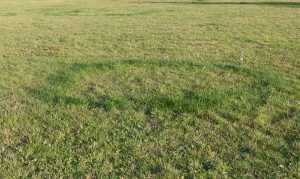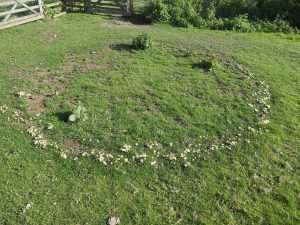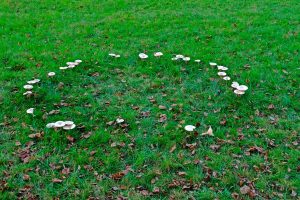Understanding fairy rings in your lawn
Published on May 6, 2024 at 11:46am CDT
Growing Green
By Robin Trott, Extension Educator



Have you noticed circular patches of greener grass in your lawn?
It’s not uneven fertilizer but fungi feeding on decomposing matter like old tree stumps, leaves or roots, releasing nitrogen. This phenomenon is called a fairy ring.
Fairy rings are circular areas of abnormal turf growth, commonly found in lawns with elevated organic matter or after tree removal. Their mysterious, circular appearance has fascinated people since ancient times, with medieval lore linking them to dancing fairies.
What do fairy rings look like? They’re grass rings up to 15 feet in diameter with a distinctly different color or texture compared to the surrounding grass. Partial ring patterns can also occur, and in wet weather, rings of mushrooms may form at the edge of the discolored grass.
Where do fairy rings come from? Certain fungi feed on decaying organic matter buried in the soil, growing outward in a circular pattern. Three types exist, depending on soil type, the specific fungus, and environmental conditions:
• Type 1: Common on golf course putting greens, these rings cause grass to brown and die due to reduced water absorption.
• Type 2: Efficiently decays organic matter, releasing nitrogen that promotes lush grass growth.
• Type 3: Features rings of mushrooms, especially during wet periods like fall.
What should you do with fairy rings in your lawn? The good news is that fairy rings do not kill lawns and are mainly cosmetic. They often disappear naturally. Waiting is usually the simplest management option. For preemptive measures, consider routine core aeration to reduce thatch buildup. For Type 2 rings, apply nitrogen fertilizer to match grass colors. For Type 3, carefully remove mushrooms (wearing gloves) and dispose of them; DO NOT EAT THEM as they may be poisonous. Avoid using fungicides
as they’re typically ineffective against fairy rings.
For more information on lawn care, visit the turfgrass science page at https://turf.umn.edu/ and subscribe to the lawn care newsletter.
Until next time, happy gardening!




